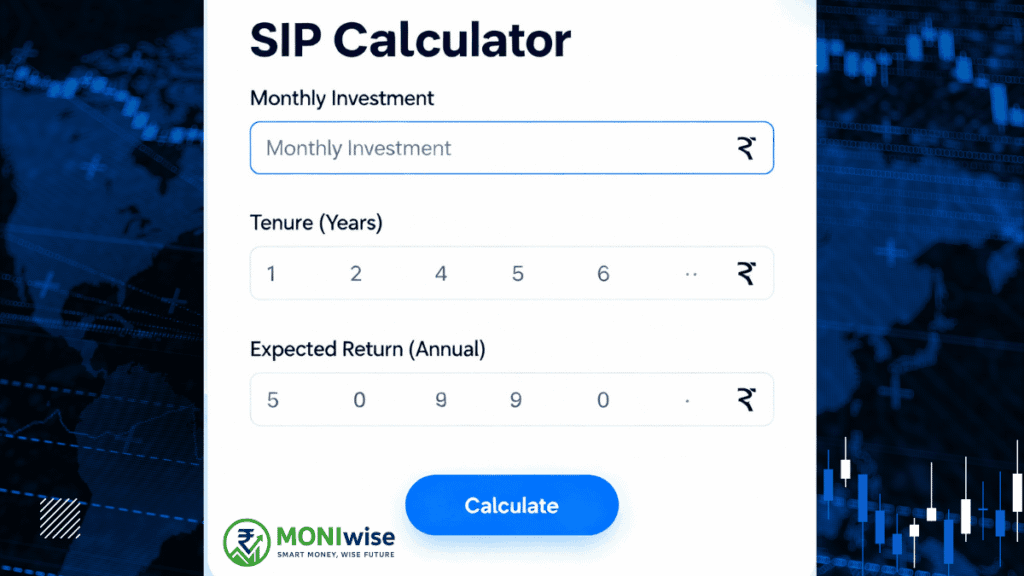📊 Position Size Calculator
Calculate your ideal trade size based on risk management principles
Trading in the stock market requires more than just identifying good opportunities—it demands disciplined risk management. The Position Size Calculator is an essential tool that helps traders determine the optimal number of shares or contracts to buy or sell based on predefined risk parameters. Whether you're trading on NSE, BSE, or any other exchange, knowing your exact position size prevents emotional decisions and protects your capital from devastating losses.
This free online position size calculator is designed specifically for Indian traders engaged in equity delivery, intraday trading, futures, and options. By inputting just four simple parameters—total capital, risk percentage, entry price, and stop loss—you can instantly calculate your ideal trade size and ensure your risk exposure aligns with your trading strategy.
What is Position Sizing in Trading?
Position sizing refers to the process of determining how many units of a financial asset (shares, lots, contracts) to include in a single trade. It's a critical component of risk management that ensures you don't risk more capital than you can afford to lose on any single trade.
The fundamental principle is simple: Never risk more than 1-2% of your total trading capital on a single trade. This approach ensures that even a series of consecutive losses won't significantly deplete your account, allowing you to stay in the game long enough for your winning trades to compound.
For example, if you have ₹1,00,000 in your trading account and follow the 2% risk rule, you should never risk more than ₹2,000 on any single trade. The position size calculator automatically computes how many shares you can buy at a given entry price with a specific stop loss to maintain this risk limit.
Why Position Sizing is Critical for Trading Success
Most retail traders fail not because they can't identify good trading opportunities, but because they fail to manage risk properly. Here's why position sizing is crucial:
Capital Preservation: By limiting your risk per trade, you protect your capital from catastrophic losses. Even if you're wrong on 5-7 trades in a row (which happens to every trader), you'll still have 85-90% of your capital intact.
Emotional Control: When you know exactly how much you're risking and that it's within your comfort zone, you're less likely to panic and exit trades prematurely. This psychological edge is invaluable.
Consistent Returns: Professional traders focus on consistency rather than home runs. Position sizing ensures your winners can compensate for your losers over the long term, leading to steady account growth.
Prevents Over-Leveraging: Many traders, especially beginners, tend to take oversized positions hoping for quick profits. This often leads to margin calls and account wipeouts. A position size calculator prevents this mistake.
How to Calculate Position Size: Step-by-Step Guide (H2)
Calculating your position size manually involves several steps, but our calculator automates the entire process. Here's the methodology behind the calculations:
Step 1: Determine Your Risk Per Trade
Decide what percentage of your total capital you're willing to risk. Conservative traders use 0.5-1%, moderate traders use 1-2%, and aggressive traders may go up to 5%.
Formula: Risk Amount = Total Capital × Risk Percentage ÷ 100
Example: ₹1,00,000 × 2% = ₹2,000
Step 2: Calculate Risk Per Share
This is the difference between your entry price and stop loss price.
Formula: Risk Per Share = Entry Price – Stop Loss Price
Example: If entry is ₹500 and stop loss is ₹490, risk per share = ₹10
Step 3: Compute Position Size
Divide your total risk amount by the risk per share.
Formula: Position Size = Risk Amount ÷ Risk Per Share
Example: ₹2,000 ÷ ₹10 = 200 shares
Step 4: Calculate Total Investment
Multiply your position size by the entry price to know your total capital requirement.
Formula: Total Investment = Position Size × Entry Price
Example: 200 shares × ₹500 = ₹1,00,000
This systematic approach ensures you never exceed your predetermined risk threshold, regardless of market conditions.
Key Components of the Position Size Calculator
Our position size calculator requires four essential inputs to provide accurate results:
1. Total Trading Capital (₹)
This is the total amount of money available in your trading account. It's crucial to use your actual account balance, not your gross income or net worth. The calculator uses this figure to compute your maximum risk per trade based on your risk percentage.
2. Risk Per Trade (%)
This is the percentage of your capital you're willing to lose on the trade if your stop loss is hit. Most professional traders recommend:
- Ultra-conservative: 0.5%
- Conservative: 1%
- Moderate: 2%
- Aggressive: 3-5% (not recommended for beginners)
The calculator defaults to 2%, which is considered optimal for most retail traders.
3. Entry Price (₹)
The price at which you plan to enter the trade. This should be based on your technical analysis, support/resistance levels, or breakout points.
4. Stop Loss Price (₹)
The predetermined exit point where you'll close the trade to prevent further losses. Your stop loss should be placed at a technically significant level, not arbitrarily. The difference between entry and stop loss determines your risk per share.
Benefits of Using a Position Size Calculator
Time-Saving: Manual calculations can be time-consuming and error-prone, especially when you're analyzing multiple opportunities. The calculator provides instant results.
Accuracy: Eliminates mathematical errors that could lead to incorrect position sizing and excessive risk.
Discipline: By calculating your position size before entering any trade, you develop disciplined trading habits that separate professionals from amateurs.
Flexibility: Easily test different scenarios by adjusting your risk percentage or stop loss levels to see how they impact your position size.
Risk Visualization: The calculator provides a complete breakdown showing your risk amount, risk per share, total investment, and risk-reward ratio, helping you make informed decisions.
Portfolio Protection: Ensures you maintain proper diversification and don't allocate too much capital to a single position.
Position Sizing Strategies for Different Trading Styles
Intraday Trading
Intraday traders typically use tighter stop losses and may take multiple positions throughout the day. A conservative 1-2% risk per trade is recommended. Since positions are closed before market close, you can potentially use the same capital for multiple trades if earlier trades are successful.
Swing Trading
Swing traders hold positions for several days to weeks and generally use wider stop losses. A 1-3% risk per trade is common. Since your capital is locked for longer periods, proper position sizing ensures you have enough liquidity for other opportunities.
Positional Trading
Long-term positional traders may hold for months and can afford to use 0.5-2% risk per trade with even wider stop losses. The focus here is on high-probability setups with excellent risk-reward ratios of 1:3 or better.
Futures & Options Trading
F&O trading involves leverage, making position sizing even more critical. Calculate your position size based on the actual capital required (margin + additional buffer) rather than your total account value to avoid over-leveraging.
Common Position Sizing Mistakes to Avoid
Risking Too Much Per Trade
New traders often risk 10-20% or more per trade, hoping for quick profits. This approach invariably leads to account depletion after a few losing trades.
Ignoring Market Volatility
In highly volatile markets, wider stop losses are necessary. Failing to adjust your position size accordingly can result in oversized positions.
Not Using Stop Losses
Some traders calculate position size but then don't actually place stop loss orders. This defeats the entire purpose of risk management.
Arbitrary Stop Loss Placement
Placing stop losses based on your desired position size rather than technical levels is a recipe for disaster. Always identify your stop loss first, then calculate your position size.
Overtrading
Taking too many positions simultaneously, even with proper position sizing on each trade, can result in excessive overall portfolio risk.
Advanced Position Sizing Techniques
Fixed Percentage Method
This is the most common approach where you risk a fixed percentage of your capital on each trade. As your account grows, your position sizes automatically increase, and vice versa.
Fixed Fractional Method
Similar to fixed percentage but adjusts for the risk of the specific trade. You divide your risk percentage by the percentage distance to your stop loss.
Kelly Criterion
A mathematical formula that calculates optimal position size based on your win rate and average win/loss ratio. Formula: f = (bp – q) / b, where f is the fraction to bet, b is the payoff ratio, p is win probability, and q is loss probability.
Volatility-Based Sizing
Uses indicators like Average True Range (ATR) to adjust position sizes based on market volatility. Higher volatility = smaller positions, lower volatility = larger positions.
Frequently Asked Questions (H2)
What is the ideal risk percentage per trade?
For most retail traders, 1-2% risk per trade is optimal. This allows you to sustain 20-50 consecutive losses before significant account depletion, which is statistically unlikely even for losing strategies.
Can I use this calculator for options trading?
Yes, the calculator works for options, but remember to input the option premium as your entry price and calculate your stop loss based on option prices, not the underlying stock price.
Should I include brokerage in my calculations?
Yes, ideally you should factor in brokerage, STT, and other charges. Add these to your risk per share calculation for more accurate position sizing.
What if my calculated position size requires more capital than I have?
This indicates that either your stop loss is too tight for your account size, or your risk percentage is too conservative. You can either widen your stop loss (if technically feasible) or increase your risk percentage slightly.
How do I adjust position size for multiple positions?
If you're holding multiple positions simultaneously, reduce your risk per trade accordingly. For example, if you hold 3 positions, use 0.5-1% risk per trade instead of 2% to keep total portfolio risk at 2-3%.
Conclusion
Position sizing is the cornerstone of successful trading and the difference between professional traders and those who consistently lose money. By using our free Position Size Calculator, you eliminate guesswork and emotional decision-making from your trading process.
Remember that even the best trading strategy will fail without proper risk management. Make it a habit to calculate your position size before every single trade, and never deviate from your predetermined risk parameters regardless of how confident you feel about a particular opportunity.
The calculator is designed to work seamlessly on all devices—desktop, tablet, and mobile—so you can access it wherever you trade. Bookmark this page and use it as your go-to tool for risk management in your trading journey.
Start protecting your capital today. Use the Position Size Calculator above to calculate your ideal trade size and trade with confidence, discipline, and consistency.


